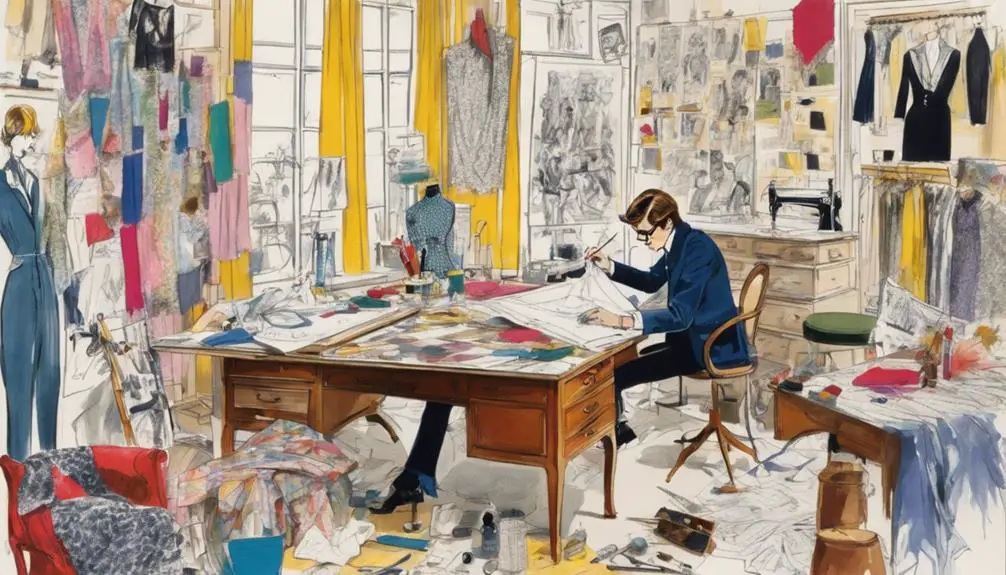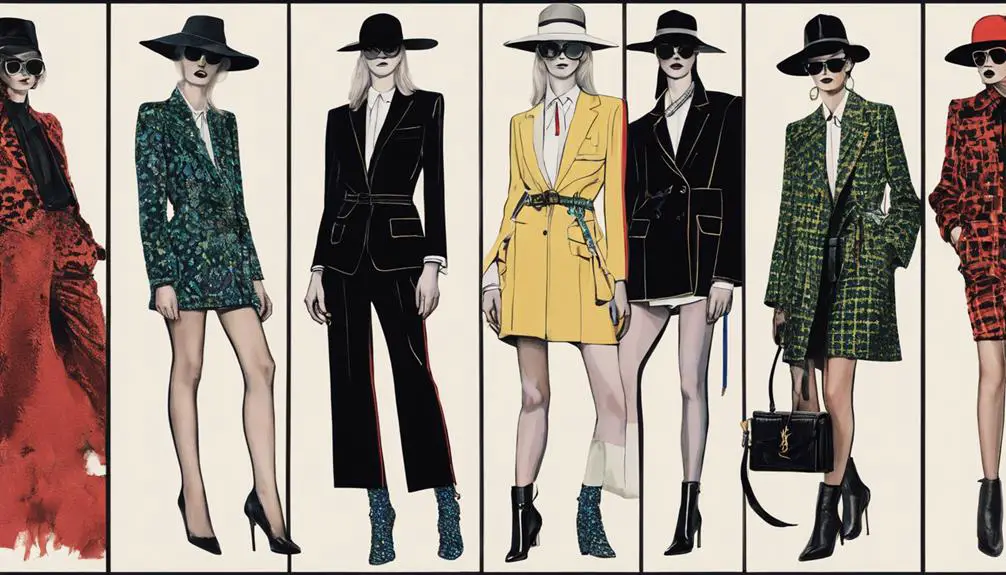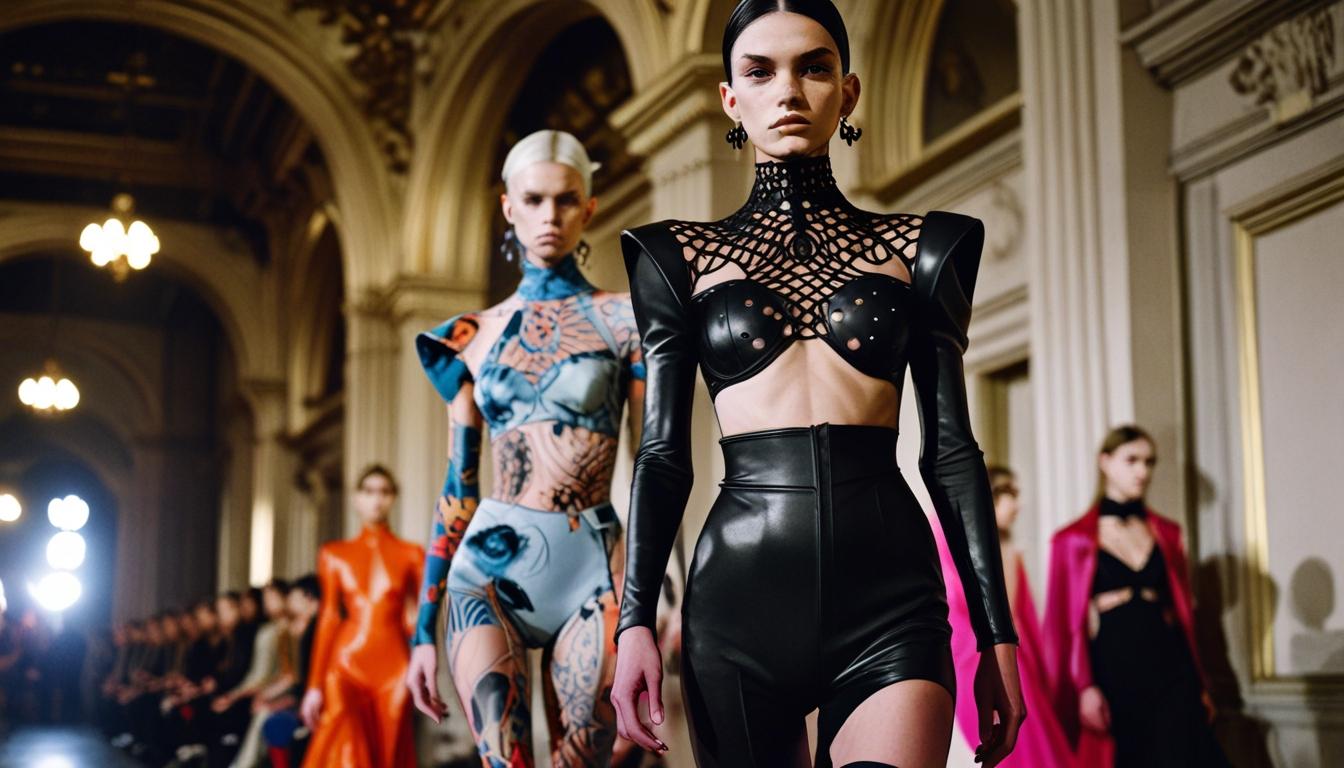The House of Saint Laurent is known for its groundbreaking moments that shaped fashion history. Starting in 1957, Yves Saint Laurent became the youngest couturier at Dior, introducing the Trapeze line and relaxed silhouettes that echoed women's liberation. He famously created the "Le Smoking" tuxedo suit in 1966, challenging gender norms and redefining femininity. His bold, colorful designs throughout the 70s celebrated individuality and artistic expression. Collaborations with cultural icons and innovative marketing strategies kept the brand at the forefront of fashion. So, if you're curious about how these moments influenced style around the world, you might want to explore further!
Early Career Milestones

Yves Saint Laurent's early career is marked by remarkable milestones that set the stage for his legendary status in fashion. At just 21 years old, you'd find him inheriting the Dior fashion house in 1957, making him the youngest couturier in history. This was no small feat!
With his first collection, he introduced the Trapeze line, a significant shift from Christian Dior's focus on small waists. Instead, Yves celebrated relaxed silhouettes that exuded a sense of freedom and comfort, which reflected the cultural movements of the time, including the push for women's liberation and self-expression.
In his first couture collection, he showcased a groundbreaking fichu-tied printed silk dress. This innovative design highlighted his unique approach to haute couture, emphasizing fluidity and movement. People couldn't help but notice the fresh perspective he brought to the fashion scene, blending classic elegance with modern ideals.
In 1961, you'd see Yves Saint Laurent taking another bold step by establishing his eponymous fashion house alongside Pierre Bergé. This partnership further solidified his influence and creativity in the fashion world, allowing him to pioneer ready-to-wear fashion that made high fashion more accessible.
Yves defined a new era of youth and rebellion, drawing inspiration from a circle of iconic women who shaped his creative vision.
These milestones weren't just impressive; they laid the groundwork for a fashion revolution. So, as you explore the story of Yves Saint Laurent, remember how these early achievements not only changed his life but also transformed the landscape of fashion forever.
Iconic Fashion Innovations
Saint Laurent's innovative spirit transformed the fashion industry, introducing bold designs that challenged traditional gender norms. You can see this clearly in his groundbreaking "Le Smoking" tuxedo suit from 1966. This iconic piece empowered women to embrace androgyny, allowing them to step into the world of high fashion with confidence.
As you explore deeper into Saint Laurent's journey, you'll discover how his creativity as a creative director led to other iconic fashion innovations.
Take, for instance, the 1971 "Safari" collection. It skillfully combined masculine and feminine silhouettes, featuring pieces like safari jackets and cigarette pants that prioritized both practicality and elegance.
Additionally, Saint Laurent's Trapeze line from 1958 shifted the fashion narrative away from restrictive waistlines, promoting a relaxed and youthful silhouette that many still admire today.
His use of bold colors and vibrant prints during the 1970s set a trend that celebrated individuality and artistic expression, making it one of Saint Laurent's best eras. Each collection invited you to explore a world where fashion wasn't just about clothing but a reflection of personal identity and freedom.
These iconic fashion innovations didn't just change wardrobes; they transformed how society viewed gender and style. Yves Saint Laurent's legacy continues to inspire new generations of designers, proving that fashion can be a powerful form of self-expression.
Cultural Influences and Inspirations

From the vibrant streets of Marrakech to the rich textures of the Maghreb, cultural influences played a pivotal role in shaping the vision behind Saint Laurent's collections. Yves Saint Laurent drew deep inspiration from diverse cultures, particularly his North African roots. Marrakech wasn't just a retreat; it was a wellspring of creativity for him. The colors and patterns of the region infused his designs, creating a unique blend that celebrated both heritage and global aesthetics.
Vintage fashion, much like Saint Laurent's work, often reflects the cultural zeitgeist of its time, making it a treasure trove for collectors and enthusiasts alike identifying vintage pieces.
One of the most groundbreaking moments in fashion was Saint Laurent's introduction of the Le Smoking tuxedo suit in 1966. This wasn't just a stylish piece; it was a bold cultural statement that challenged traditional gender norms and empowered women. It showed how fashion could be a vehicle for social change, a theme that resonated throughout the 1960s and 1970s.
You might notice that Saint Laurent's collections are filled with vibrant colors and bold prints. These elements celebrate artistic movements and cultural motifs that reflect the shifting social landscape of the time.
Hedi Slimane, the creative director who followed in Saint Laurent's footsteps, continued this tradition of drawing from cultural influences. His designs echoed the spirit of liberation and individuality that the brand originally championed.
In every seam and stitch, you can see how Saint Laurent's love for culture transformed fashion, making it a tapestry of stories waiting to be told.
Collaborations and Partnerships
As the brand evolved, the collaborations expanded to include prominent photographers like Henry Clarke and David Bailey. Their striking imagery in Vogue and other magazines helped enhance Saint Laurent's visual identity, making the brand even more recognizable.
Fast forward to the era of Hedi Slimane, and you'll see how his first menswear campaign featured female model Saskia de Brauw. This bold move challenged traditional gender norms and emphasized androgyny, a theme central to Slimane's vision for Saint Laurent.
The house's collaborations didn't stop at fashion. It engaged with cultural icons like Courtney Love and Marilyn Manson, merging music and fashion in a way that resonated deeply with the indie rock culture. Slimane's artistic vision shone through these partnerships, showcasing how interconnected these worlds can be.
Yves Saint Laurent also revolutionized marketing by collaborating with various artists and designers, launching limited edition collections that celebrated the brand's rich history while engaging contemporary creative communities.
These collaborations not only pushed boundaries but also solidified Saint Laurent's place in both fashion and culture.
Legacy and Brand Evolution

Yves Saint Laurent's legacy in fashion is a powerful narrative of innovation and evolution that continues to resonate today. When Yves introduced ready-to-wear fashion in the 1960s, he transformed the industry. Suddenly, women had access to stylish clothing that was both fashionable and functional. This shift empowered women, allowing them to express themselves through their wardrobes like never before.
One of the most iconic moments in Yves' career came in 1966 with the launch of the "Le Smoking" tuxedo suit for women. This bold move challenged traditional gender norms and redefined what femininity could look like. Yves Saint Laurent wasn't just designing clothes; he was making a declaration.
After Yves stepped back in 2002, the brand experienced a revitalization under Tom Ford. From 1999 to 2004, Ford emphasized sex appeal and modernity, breathing new life into the Saint Laurent legacy.
Then, in 2012, Hedi Slimane rebranded the label to Saint Laurent Paris. This strategic move not only doubled sales to about $800 million but also connected with a younger audience, solidifying the brand's identity.
Currently, with Anthony Vaccarello as creative director since 2016, the evolution continues. He integrates menswear influences while honoring the rich history that Yves left behind.
The House of Saint Laurent stands as a symbol to the power of innovation and the lasting impact of its founder's visionary spirit. The legacy of Saint Laurent lives on, inspiring future generations in the world of fashion.



